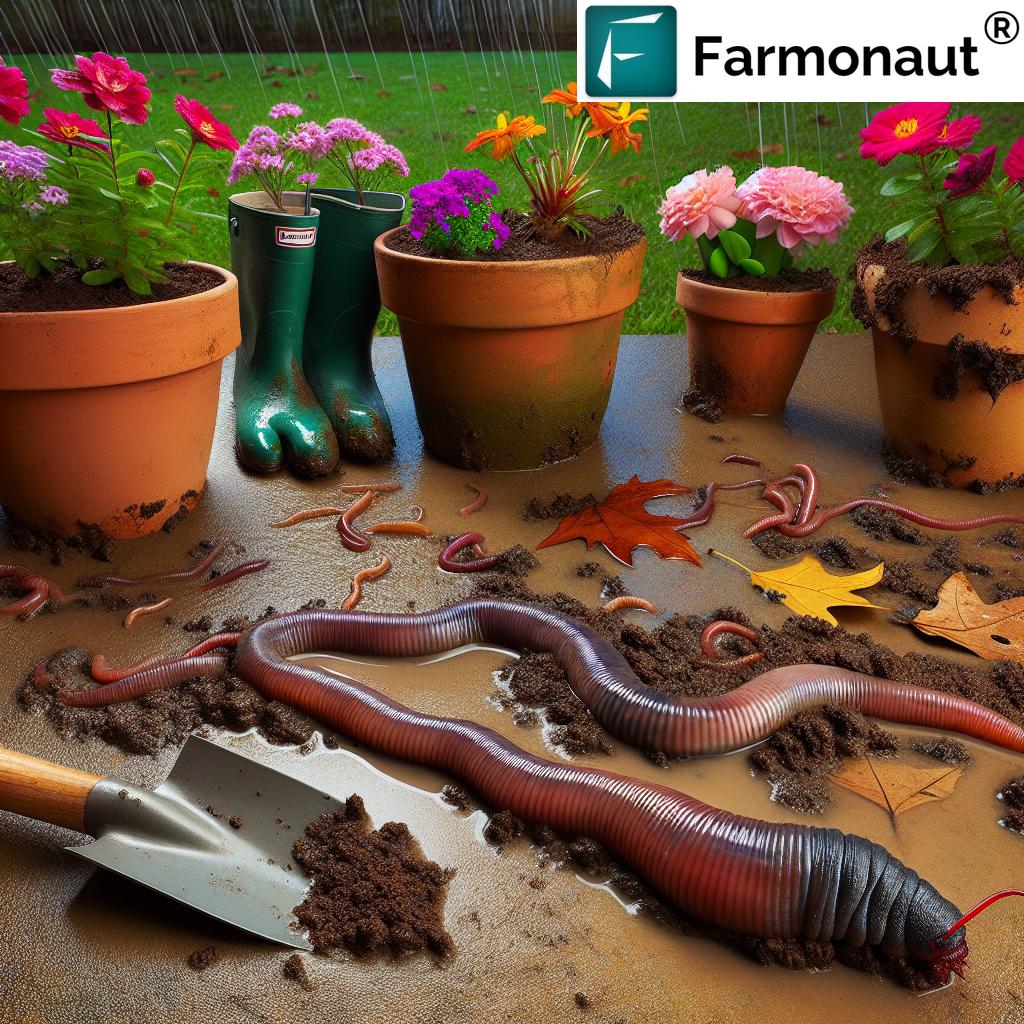Arkansas Springtime Bugs: 7 Smart Ways to Eliminate Invasive Worms
Meta Description: Arkansas springtime bugs, including hammerhead worms, threaten backyards and pets. Discover 7 expert methods to safely eliminate invasive worms and protect your home.
“Hammerhead worms can regenerate from just 1/300th of their body, making them tough to eliminate in Arkansas yards.”
Table of Contents
- Introduction: Arkansas Springtime Bugs & Invasive Threats
- What Are Hammerhead Worms? Understanding Invasive Worms in Little Rock
- Why Are Hammerhead Worms Dangerous in Your Backyard?
- How to Identify Hammerhead Worms & Other Invasive Bugs
- Prevention: Stop the Spread of Invasive Worms in Arkansas
- 7 Smart Ways to Eliminate Invasive Worms
- Comparative Table: Invasive Worm Removal Strategies
- Protecting Pets & Kids from Dangerous Worms
- Farmonaut Technology: Enhancing Pest Management in Arkansas Agriculture
- How to Get Started with Farmonaut: Apps & Subscriptions
- Frequently Asked Questions (FAQ)
- Conclusion
Introduction: Arkansas Springtime Bugs & Invasive Threats
Springtime in Arkansas is a season of renewal, but it can also bring unwelcome visitors to our homes and gardens. As spring weather and pests in Arkansas return, many of us notice an uptick in bugs—from familiar nuisances to invasive species that threaten our backyards, pets, and even the health of our soil and crops. Among the most concerning springtime bugs are hammerhead worms, an invasive species known for their striking appearance and dangerous effects.
For those living in areas like Little Rock and across the state, these worms pose risks not only to our earthworms (which are essential for healthy soil and gardens) but also to our pets and children. Understanding the problem, as well as practical steps for eliminating invasive worms, is vital to protecting our homes, garden areas, and overall agricultural environment.
What Are Hammerhead Worms? Understanding Invasive Worms in Little Rock
Hammerhead worms, scientifically known as Bipalium species, are flatworms named after their unique, arrow- or hammer-shaped head. These invasive worms have become an increasing concern throughout Arkansas, particularly in urban and suburban locations like Little Rock, where moist places attracting worms—such as shaded gardens, flower pots, and mulched beds—offer ideal environments for these organisms to thrive.
Often mistaken for harmless earthworms due to their long, slimy appearance, hammerhead worms are predatory and highly invasive. Their favorite prey? Our beneficial earthworms. While earthworms contribute to rich, aerated soil and promote agricultural productivity, hammerhead worms feed on them and can sharply reduce earthworm populations, undermining the health of Arkansas gardens and farm soils.
Hammerhead worms aren’t native to the United States. Their spread has accelerated due to global plant trade, with these organisms easily spreading through flower pots and other containerized plants. With each spring, as weather, pollen, and bugs become part of our daily Arkansas life, the risk of encountering these alien invaders grows—underscoring the importance of safe handling and effective removal methods.
Why Are Hammerhead Worms Dangerous in Your Backyard?
Our region’s dangerous worms in backyard present more than an aesthetic issue. Hammerhead worms secrete a toxic slime containing a neurotoxin similar to that found in pufferfish—making them a real hazard if ingested by pets or young children. Vic Ford, Retired Associate Vice President for the University of Arkansas Division of Agriculture, recommends that we avoid direct contact with these worms altogether.
- If eaten, these worms can make both humans and animals sick, sometimes severely.
- The toxin in their slime can linger on surfaces or hands, making it important to use gloves or tools for safe handling of garden pests during removal.
- Unfortunately, cutting up these worms won’t destroy them—instead, it helps them multiply. Each fragment can regenerate into a full worm, intensifying the infestation in Arkansas backyards.
These traits mean that hammerhead worms Arkansas are not only persistent but challenging to eliminate. They thrive in moist places attracting worms, especially following periods of heavy spring rainfall, and are aided by Arkansas’ rich, loamy soils and favorable climate.
“One hammerhead worm can lay up to 20 eggs at once, rapidly increasing their population in springtime gardens.”
How to Identify Hammerhead Worms & Other Invasive Bugs
It’s critical for us, as homeowners and gardeners in Arkansas, to recognize these invasive worms on sight, enabling rapid elimination before they spread further in Little Rock and beyond.
- Appearance: Hammerhead worms can range from 4 to 12 inches long. Their most distinguishing feature is the shovel- or hammer-shaped head. Their coloration may vary (brown, yellow, or gray) with black or dark stripes.
- Movement: They glide across surfaces using a layer of mucus/slime—a key factor in their toxicity and why gloves are so important for safe handling.
- Habitat: Look for these worms in moist locations, such as under rocks, logs, garden mulch, and especially flower pots (a key vector for spreading invasive species through flower pots).
- Time of Year: Early spring through late summer, especially after rain or in periods of high humidity, is peak worm activity in Arkansas.
If you notice worms that fit this description, it’s time to take action using safe, effective removal methods.
Prevention: Stop the Spread of Invasive Worms in Arkansas
Preventing the introduction and spreading of invasive worms in Little Rock and greater Arkansas is far more effective (and less stressful) than dealing with an out-of-control infestation. Here’s what we should do to stop these worms before they become a serious problem:
- Inspect all new plants and flower pots for signs of worms or eggs before bringing them into your garden or home.
- Quarantine new garden additions for at least a week; keep them away from moist beds and prime springtime soil to reduce accidental contamination.
- Regularly turn over rocks, logs, and moist garden debris to check for worms hiding underneath.
- Improve drainage and reduce constant moisture in garden beds, which helps limit favorable habitats for invasive bugs.
- Keep pets and children away from suspicious-looking worms or slime trails.
Because hammerhead worms hitchhike so effectively in flower pots and moist containerized plants, careful inspection and isolation are important first lines of defense.
7 Smart Ways to Eliminate Invasive Worms (How to Get Rid of Hammerhead Worms)
Once we’ve identified and prevented the initial spread, the next step is safe and effective removal. Here are seven science-backed, practical strategies to eliminate Arkansas springtime bugs—especially hammerhead worms—from your backyard, garden, or home environment.
1. Physical Removal with Safe Handling
Wear disposable gloves when handling worms. Using tweezers or gloved hands, carefully place the worm into a sealable plastic bag or container. Do not touch worms with bare hands; their slime may transmit toxins, and accidental ingestion (from hand-to-mouth) can cause illness in pets or children.
- Never squash or chop up worms, as each segment can regenerate into a new worm.
- For extra safety, seal the bag and place it in the freezer before disposal.
2. Salt Application (Effective, Targeted Elimination)
As suggested by experts like Vic Ford, applying coarse salt directly onto hammerhead worms is a quick, targeted method. The salt dehydrates the worm, causing rapid demise—ideal for isolated encounters. After salting, safely dispose of worm remains in a sealed bag. Always avoid barehanded contact.
3. Vinegar Solution
Plain white vinegar, poured over the worm, quickly neutralizes it by breaking down its tissues. Vinegar is safe for use around most plants and can be combined with salt for small-scale infestations. Avoid splashing, as vinegar can harm some delicate ornamentals.
4. Citrus or Citrus Oil-Based Repellents
Citrus peels or diluted citrus oils serve as a natural deterrent. While not a stand-alone solution for large infestations, laying lemon or orange peels near moist places attracting worms—such as under flower pots or around garden beds—can make these locations less appealing to worms and other garden bugs.
5. Diatomaceous Earth Barriers
Use food-grade diatomaceous earth to create a powder barrier around garden beds or vulnerable moist areas. This natural mineral is abrasive to invertebrates and disrupts their movement. It’s safe for pets and children if used as directed—just be sure the powder remains dry for maximum effectiveness.
6. Organic Traps & Baits
DIY organic traps (such as shallow containers with damp paper towels, baited with earthworm-scented compost) can help attract and contain invasive worms for safe disposal. Check these traps daily, wearing gloves, and never reuse trap materials in your soil.
7. Enhanced Sanitation & Landscape Modification
By regularly tidying your backyard, removing debris, and improving drainage, you make the environment less attractive for hammerhead worms and other springtime bugs. Eliminating excess mulch and avoiding over-watering can reduce moist hiding places.
- Trim and thin plantings to increase air circulation, helping soil dry out between rain events.
- Elevate flower pots and containers to allow for airflow beneath, discouraging worm habitation.
Comparative Table: Invasive Worm Removal Strategies
To help our Arkansas communities make smart, informed decisions about how to get rid of hammerhead worms and similar invasive bugs, we’ve compiled a detailed table comparing each major solution. Analyze the effectiveness, safety, application complexity, and estimated cost to choose the best method for your household.
| Method | Estimated Effectiveness (%) | Pet/Kid Safe (Yes/No) | Application Complexity (Low/Medium/High) | Estimated Cost ($) |
|---|---|---|---|---|
| Physical Removal (with gloves) | 90 | Yes | Low | 1–5 |
| Salt Application | 95 | Yes (with supervision) | Low | 1–3 |
| Vinegar Solution | 90 | Yes (spot use) | Low | 2–5 |
| Citrus/Citrus Oil Repellents | 40 | Yes | Low | 3–7 |
| Diatomaceous Earth Barriers | 75 | Yes | Medium | 8–15 |
| Organic Traps & Baits | 50 | Yes | Medium | 2–10 |
| Enhanced Sanitation & Landscaping | 65 (prevention) | Yes | Medium | 0–20 |
Protecting Pets & Kids from Invasive Worms and Bugs
With toxins in the worm’s slime and body, extra efforts are needed to keep pets and children safe during Arkansas springtime bugs season.
- Always keep pets and children indoors or supervised during garden cleanups, especially after heavy rain when worms are most active.
- Do not let pets sniff, lick, or handle worms (even dead ones).
- Store all removal agents (salt, vinegar, diatomaceous earth) safely, out of reach.
- Teach children to alert an adult if they see a strange-looking worm or bug.
- Wash hands thoroughly after gardening and worm removal activities.
If accidental ingestion or suspected contact occurs, consult a veterinarian or medical provider promptly.
Farmonaut Technology: Enhancing Pest Management in Arkansas Agriculture
To strengthen our defense against invasive bugs and optimize pest management across Arkansas’ farms and yards, we can leverage advanced satellite-powered platforms like Farmonaut. Farmonaut offers an exceptional suite of precision agriculture technologies to help commercial growers, urban gardeners, and backyard owners track and manage challenges like pests, soil moisture, and springtime infestations.
- Satellite-Based Crop Health Monitoring: Farmonaut uses multispectral satellite imagery to measure crop health, analyze vegetation, and detect soil moisture issues. These insights let us spot problem areas prone to moist places attracting worms long before infestations grow.
- AI-Based Pest & Weather Advisory: The Jeevn AI advisory system delivers customized recommendations using current weather data, pest patterns, and crop specifics for smarter, more timely interventions across gardens and large-scale fields.
- Blockchain Traceability: For home growers or commercial farmers who want to certify their produce’s pest-free status, Farmonaut offers blockchain-based product traceability. This system builds consumer trust while supporting transparent, sustainable farm-to-market pipelines.
- Resource & Fleet Management: For larger operations, the platform’s fleet management tools help deploy resources efficiently, supporting hygiene and sanitation protocols essential to limit pest spread between locations.
- Carbon Footprinting: By deploying methods that minimize broad pesticide use, integrating carbon footprint tracking can further incentivize safe, sustainable pest management in Arkansas’ spring landscapes.
- Loan & Insurance Verification: Secure data on crop and soil health supports crop loan and insurance processes, providing verifiable protection for farmers facing pest losses.
Farmonaut’s mission is to make such cutting-edge large scale farm management tools affordable and accessible for every farmer, gardener, or agribusiness in Arkansas and beyond.
Discover Farmonaut’s Satellite & Weather API for developers and researchers (enable integration of satellite pest and weather insights into your own Arkansas location or business solutions).
How to Get Started with Farmonaut: Apps & Subscriptions
Empowering our gardens and farms with technology is easier than ever. Farmonaut offers:
- Web and Mobile App Access for instant satellite health and pest risk insights on any device—try now.
- Android & iOS Apps for on-the-go management—Android download and iOS download.
- API & Developer Documentation for custom integrations—View API Docs.
Choose a Farmonaut plan below to monitor and defend your Arkansas property or business:
FAQ: Arkansas Springtime Bugs and Invasive Worms
What are hammerhead worms, and why are they a problem in Arkansas?
Hammerhead worms are flatworms with unique, spade-shaped heads. In Arkansas, they’re especially troublesome because they prey on beneficial earthworms, secrete toxins that can harm pets and children, and rapidly multiply due to their ability to regenerate from tiny body fragments. They are common in moist, shaded areas like backyard gardens and flower pots.
Do I need to report hammerhead worm sightings to the Arkansas Department of Agriculture?
No, according to Vic Ford, there’s no longer a need to report every sighting. The worms are now established in many Arkansas locations. The best course is to use safe, direct removal methods at home.
Are salt and vinegar safe ways to kill invasive worms?
Yes, both salt and vinegar are highly effective and are safe as long as you keep pets and children away during and after application. Always wear gloves and avoid contact with worm slime.
Can I use traditional pesticides for hammerhead worms?
Most traditional pesticides aren’t designed for flatworms and may prove ineffective against hammerhead worms. Integrated cultural and physical control methods (like those above) are preferred for homes and gardens.
How can Farmonaut help manage invasive pests?
Farmonaut provides real-time, satellite-powered crop monitoring, soil moisture analysis, and AI-based pest and weather advisory systems. These tools help identify pest-prone moist locations early, enabling rapid, targeted interventions to protect Arkansas crops, gardens, and landscapes.
What should I do if a pet or child touches or eats a hammerhead worm?
Immediately wash the affected area with soap and water, then contact a veterinarian (for pets) or physician (for children)—the worm’s toxin can cause illness if ingested.
Conclusion: Keeping Arkansas Safe from Springtime Bugs
As residents of Arkansas, we face many spring changes—from refreshing rains and vibrant blooms to the challenge of increased springtime bugs and invasive worms in Little Rock and statewide. With knowledge, vigilance, and the support of modern technology solutions like Farmonaut, we can protect our backyards, crops, and loved ones.
- Choose proven, safe methods for eliminating invasive worms, prioritizing gloved removal, targeted salt/vinegar application, and consistent landscape hygiene.
- Leverage digital tools and satellite insights to detect and prevent pest incursions on any scale.
- Encourage neighbors, gardeners, and agricultural peers to share best practices and stay alert for signs of harmful bugs as weather and pollen change each spring.
Stay proactive, keep pets and children away from toxic guests, and embrace Arkansas’ spring with confidence—knowing you have the knowledge and resources to handle any challenge that these resilient invasive worms bring.


















